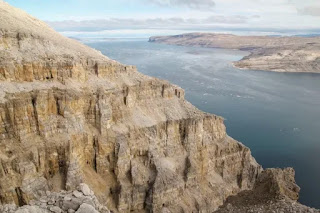Old rocks from a remote Canada island contain the most established green growth at any point found.
The examples, found on Canada's Baffin Island, likewise uncover generally when plants had the segments fundamental for photosynthesis, another examination finds.
The finding uncovers that Bangiomorpha pubescens, the most seasoned known green growth on Earth, is in excess of 1 billion years of age. Working in reverse, the specialists made sense of that green growth could likely reap the sun's vitality through photosynthesis around 1.25 billion years back.
"I believe it's really dynamite that this fossil is relatively indistinguishable to red green growth [one of the most established gatherings of green growth that still exists today], and we have demonstrated that it is more than 1 billion years of age," said think about lead scientist Timothy Gibson, a doctoral understudy in the Department of Earth and Planetary Sciences at McGill University, in Canada.
Earth's air
At the point when a plant photosynthesizes, it utilizes daylight to fuel a response amongst water and carbon dioxide, creating starches and oxygen. Microscopic organisms have been photosynthesizing since no less than 2.5 billion years back, however B. pubescens is the principal known case of an eukaryote that could photosynthesize. (Eukaryotes are living beings, for example, plants, some green growth and creatures, whose cells have a layer encompassing the core and different organelles that are inside them.)
"Before around 2.5 billion years prior, there was basically no oxygen in the sea," Gibson said.
Antiquated microbes helped change that. "This early photosynthesis is in charge of the soonest climatic oxygen," Gibson said.
Be that as it may, there was more vulnerability when it came to more unpredictable creatures' capacity to photosynthesize.
Narrowing extent
Specialists initially distributed dates for B. pubescens in 1990 in the diary Science, expressing that the green growth — which brandished the principal generally acknowledged proof for photosynthesis in plants (which incorporates green growth) — was between 1.2 billion and 720 million years of age.
In any case, this time window was huge, so in the present examination, Gibson and associates limited it by gathering and dating new examples of the dark shale found in shake layers around the green growth fossils. Their new investigation demonstrated that B. pubescens lived between 1.06 billion and 1.03 billion years prior, with its no doubt age being 1.047 billion years of age, Gibson said.
After the scientists decided the period of B. pubescens, they utilized a sub-atomic clock examination — that is, a PC display that utilizations rates of hereditary change to ascertain transformative occasions — to make sense of when photosynthesis likely started in eukaryotes.
The investigation proposes that "1.25 billion years back, a complex however minuscule life form 'gulped' a basic photosynthetic bacterium and picked up its photosynthetic forces," Gibson disclosed to Live Science in an email. "It was then ready to pass the DNA that codes for photosynthesis down to its posterity, and now, basically all advanced plants utilize a similar organelle — the chloroplast — for photosynthesis."
In any case, in spite of the fact that B. pubescens has built up when eukaryotes started to photosynthesize, it's as yet vague when Earth's oxygen levels soared to present day levels, Gibson said.
"The topic of when oxygen achieved anything like current levels is a point we are as yet attempting to bind, yet it likely wasn't until nearer to a large portion of a billion years prior," Gibson said.
At the point when the World Turned Green: Age of Plant Photosynthesis Revealed
March 07, 2018
air plants terrarium,
cactus house plants,
fairy gardens ideas,
fairy gardens plants,
Green Plants,
house plants online,
indoor plants dubai,
succulent plants for sale,
terrarium plants for sale


